
Method Studios' effects for ‘Beautiful Creatures’, from magical to photoreal, include a mile-wide tempest and animated transitions.
Beautiful Creatures |
|
Method Studios in Los Angeles began working on ‘Beautiful Creatures’ in mid-August 2012 after post production had started, some time after the shoot had completed. Their team started with an award of 90 shots, which gradually built up to just under 200. The movie, directed by Richard LaGravenese, deals with dark magic and the occult, through to death and violence, but to the end it keeps a sense of humour and romance, all of which are reflected in the style of the effects. When Method joined the project, some of the effects they were assigned had not been fully concepted, giving them a chance to add their own creativity to the story. Digital DinnerThe first sequence they tackled was a whirl-wind of a family dinner in which the characters revolve around the dining table in a swirl of smoke and other magical effects. Starting well after the shoot meant the team had no chance of capturing on set data. “However, Richard LaGravenese is a director who likes to capture as much of a scene as possible in camera,” said Method’s VFX supervisor Olivier Dumont. “When the set is viewed in wide shots, almost everything is live action, including the actors. The set itself was placed on a gimbal to add practical in-camera motion, and the floor was built in two sections that allowed the table and the floor below the characters to spin independently, in opposite directions.” |
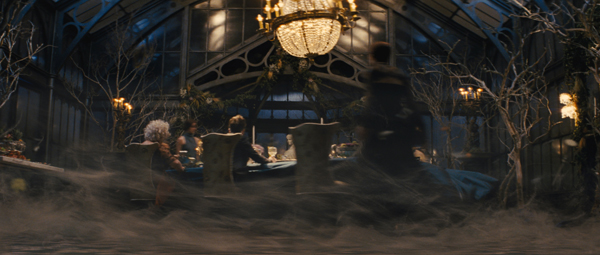 |
|
This construction not only increased the effect of speed. It resulted in a seam in the floor that had to be removed, and because Richard also wanted the entire floor to appear to be spinning while the table remained stationary, Method needed to replace the practical floor to match the characters’ motion, and then add CG smoke and effects on top of it. The actors were fixed to the dining chairs, and the chairs were secured to the floor with substantial rigs that needed a lot of cleanup, but it was more effective to replace the dinnerware on the table with digital dishes. For close-ups, the actors had been shot separately on green screen under noticeably different lighting, which meant colour correcting and adjusting the light in the green screen footage when compositing the characters onto the backgrounds. The scene also needed more camera shake, for which they separated some of the reflections from the windows in the plate, creating enough relative parallax to create a 3D camera shake effect, not just 2D motion. Dramatic ExitA high point of the sequence is when one of the girls is magically sucked out through the door to the exterior. Originally a stunt actor was captured on green screen with a locked off camera, but because this performance was somewhat disappointing, revealing evidence of the wires, Method built a digital double, animated to coordinate with the opening of CG doors onto green screen. They created an exterior digital environment seen through the doors, based on photography, adding and animating CG trees to provide realistic movement. Some of the digital dinnerware was swept out with her, with a CG peacock that gets stuck in the doorway. “At first we were only anticipating a face replacement, but replacing the whole stunt performance with CG gave us more control and allowed us to perfect the composition,” Olivier said. “The production was very helpful about supplying resources for this double and for others that we created for the film. They provided a cyberscan and numerous images of the actress from the set. Abundant HDR images for lighting were always available as well, for all of the work.” Dream DressWhen Method was first approached for ‘Beautiful Creatures’, the production was seeking ideas for realising the dream sequence at the beginning of the movie, which sets the stage for the mysterious story that follows. In a series of recurring dreams, the lead character Ethan sees a young girl, Lena, on a hillside under a stormy evening sky, while her face and identity remain obscured from view. The shots chosen for the sequence had been captured when Lena was wearing a dress that would feature in another scene, later in the film. The director therefore needed her costume to change but liked the framing and other aspects of the shot, so the key technical task here was to replace the dress whenever the camera moves close to her. Method chose to make a digital double of her body wearing the required dress, keeping the head and flowing hair as they were in the plates and focussing their efforts on building and integrating the body. The dress was created with a cloth simulation to match its looks in the wide shots, floating around her. Because the only other reference of her wearing this dress was a backlit wide shot, the production sent the actual dress to the team to use when creating the simulation, to study and replicate the fabric |
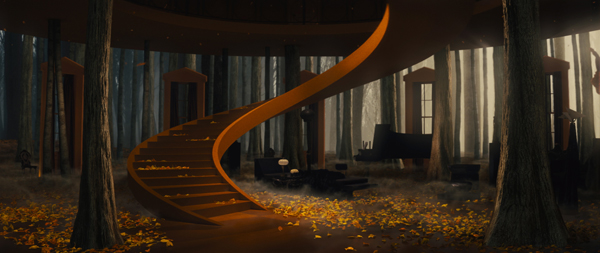 |
Day for NightTheir approach to the sequence left time for creatively enhancing the lighting and dramatic sky, which were also important to Richard LaGravenese. “The images had been captured in full daylight and needed a day for night treatment,” Oliver said. “The day for night sections had been pre-graded at the DI stage and the numbers were sent to us as CDLs, allowing us to work on the raw plate and apply the day for night grade ourselves after making some of our own enhancements, but still allowing us to reverse it. We also made a matte painting to replace the skies in Nathan’s dream that we then enhanced with godrays and colour in the composite.” The entrance to the palatial and spooky house of Macon Ravenswood, Lena’s uncle, features a large, curving staircase. The large room changes dramatically in look and mood from sequence to sequence, starting out pure white and progressively becoming darker until it is black at the end. Unfortunately, as the shoot had progressed, these changes had not been taken into consideration – the set was always shot in its original bright white mode. At one point, it takes on an autumnal mood and appears to open out at the back to a forest entirely composed of computer generated trees and falling leaves, with a digital matte painting for the distant background. For this scene, Method was assigned to change the walls to deep orange and open the rear walls of the set to reveal the forest environment. Colour Shift“A major task for this was extracting the furniture and actors from the plate and compositing them realistically onto the new background. The white hair of the grandmother character had been shot against the white set, which made extracting each hair fairly tricky. The deep orange environment, of course, also called for quite different lighting from what existed in the plate,” said Olivier. “We had to do some colour correction ahead of the DI in order to integrate the elements, which would still be reflecting the original lights, and actually manipulate the plates so that the CG and the live action would work together. As far as possible, we colour corrected the walls to look orange without replacing them, and then corrected the elements to look as though they were in an orange room but not actually orange themselves.” |
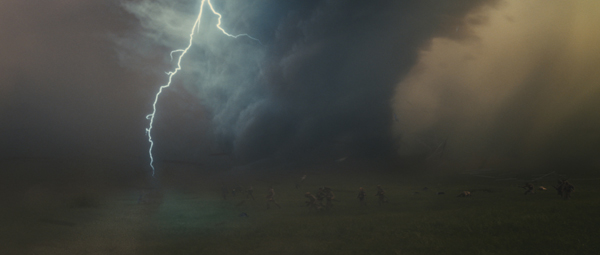 |
|
On the walls, a straightforward hue shift was not enough – all the shadows had to be re-worked for different elements, separating each one, for example the moulding on the walls, to make them look real. Overall, the scene required a lot of rotoscoping. “We’ve found that it’s useful to work directly with the DI artists in advance because if they push the range of the DI too far, it degrades the effectiveness of the composites. It helps, therefore, to know if they will be pushing the images to look darker, brighter and so on.” Roto animationWhen the evil Sarafine, in the guise of Mrs Lincoln, attempts to visit Ethan at home she first has to tangle with a magical force field that Lena has put in place around his house as protection. Losing her composure, she lets her darker side show through – with some frightening effects including black veins appearing over her face and animated tendrils emerging and wrapping around her body. Method discussed with the director just how her shifting appearance should look at various moments. Would they actually reveal Sarafine, or keep the audience guessing? Production VFX supervisor Joe Harkins and Richard explained fairly clearly what they wanted and the team arrived at the right look for the effects without too many iterations. “Mostly, we continue to see Mrs Lincoln combined with these effects,” said Olivier. “But by the end, Richard wanted to show that the other entity, Sarafine, is inside of her. Therefore, in the composite, we added flashes of Sarafine’s face based on a CG model of the actress. “The Mrs-Lincoln-to-Sarafine shift and the veins required roto animating this CG model to get the CG surface to match the movements and gestures of Mrs Lincoln. We then placed a set up of curves on the CG surface that allowed us to deform this surface accordingly. Combining the results gave us the displacement. The colour correction was added in the composite, before integrating all of the effects. “Our main challenge was getting a very precise, realistic roto animation. Even when the skin is stretching, for example, you need to be able to achieve the same stretching in the CG model as well. Otherwise you have the impression of the effect sliding over the surface of the skin. To achieve the look of the dark veins lying just below the surface is applied as a subsurface quality, in the render.” Procedural AnimationThe long tendrils extending from Mrs Lincoln/Sarafine’s body were animated procedurally. Particles were initially emitted from her body, each producing its trajectory, into a turbulence field, giving them a random path which, in this example, produces curves. Animating this turbulence field, in turn, animates the curves. “After that, the final looks depended on the render,” explained Olivier. “But the movement was about getting this procedural effect working well, testing and defining it to find the correct base, animation and quantity. Joe and Richard didn’t want something that looked like lightning, for instance but more vine-like and very light.” |
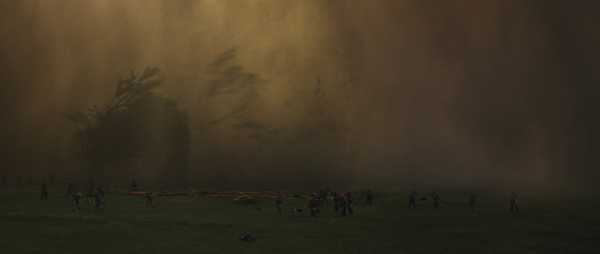 |
|
The force field look was somewhat different, because it needed to relate to a much grander electrical force field effect another vendor created in a sequence near the end of the film. The same effect would have overwhelmed the setting of a suburban house, so Method needed to scale it back while keeping an electrical look and feel. Method’s CG pipeline is based on Maya, which was also used for Sarafine’s rotoanimation. All of the effects they developed for the film were created in Houdini, but critical to the looks of all effects and CG was the compositing, done in Nuke, which was also used for much of the lighting and colour work. Maya, however, was used for the orange lighting shift for the autumn mood in the house entrance. The team used SynthEyes for tracking, and Photoshop for matte paintings. Painful TransitionLater when Sarafine transforms into vines growing against a wall, effort was devoted to making the transform from human to plant smoothly progressive, an effect that was made more difficult because Richard wanted it to look both violent and painful. To keep the required level of control, as soon as the character is fully revealed as Sarafine and leaves Mrs Lincoln behind, the footage becomes all-CG. “We were given some locked off plates, but we wanted to be able to push in, in 3D, and pull out again at the end to add to the dramatic beats. This meant replicating the wall with vines behind Mrs Lincoln,” said Olivier. “We then created two types of vines behaving in two different ways. One sort were growing against the wall and, as she was being projected against it, were animated to reach out and grab her. The second type was growing inside her, forming the fully transformed Sarafine. The progression was then created by smoothly transitioning in a series of full CG shots between these two looks. |
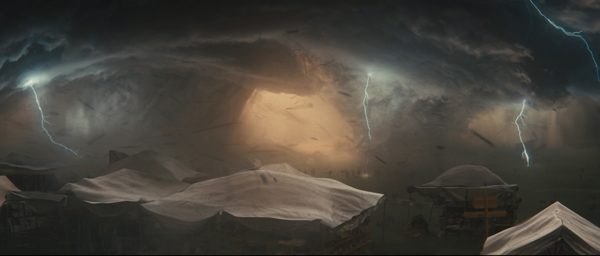 |
|
“The feeling of violence was enhanced during the composite. The artists intended to give her a ghostly look, initially due to a constraint we had from production regarding her final appearance, which was not to be recognisable as the face of Sarafine. They wanted to leave the character open for development in the movie’s sequel. So, her ghostly look was enhanced with a CG effect causing her to generate a particulate emission that leaves a streak in the image when she moves, like the trail the taillights of a car can leave in photos. By the end, this effect is combined with the black tendrils of the earlier scene, receding inside her.” Mile WideMethod’s major sequence was creating CG effects for a supercell thunderstorm at a climactic point near the end of the story. The resulting supercell asset, both supernatural and very realistic, measured approximately one mile wide and generated three distinct tornados at its centre. “Fortunately, we almost never show that full, mile-wide asset in one frame, so we could concentrate on refining the looks in the plates, which had been shot in full daylight on a sunny day,” said Olivier. “The camera moves were limited, making tracking a bit easier, but we needed to develop a colour correction scheme that grows progressively more sinister and threatening as the storm advances. It had to suggest that something was approaching, using shadows and adding more and more debris, increasing the violence through to the end |
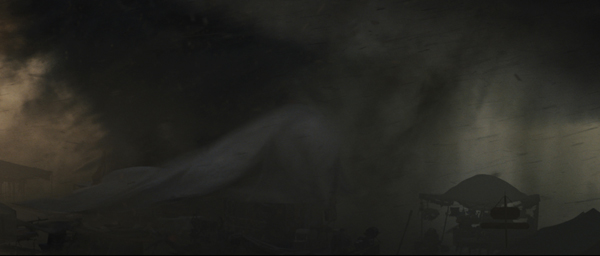 |
|
“Our team did not have a lot of time for R&D or testing for these effects. The plates were received at the end of October with only five weeks to completion. It was an interesting process for us to make the whole thing work,” Olivier said. “First, we developed a story behind what was going on behind each shot. We described to Joe Harkins how we saw it, which he then wanted us to explain to the director. Once Richard approved this, we still needed to present the sequence to the producers at the studio. “But we must have been on the right track. While previs had been done for the sequence some time earlier, they had not found a vendor whose proposals matched their original vision closely enough. For this reason it was important to establish the behind-the-scenes story and create our concepts on the key shots, especially wide shots, to determine exactly what the audience would be seeing at each point.” Storm TeamOlivier went back to the basics of the scene, compiling storm reference and images for more concepts and, as well, to define a look for the tornados. “If you look at a real tornado, it looks elegant and smooth, not as violent as it really is, relative to the destruction it causes. However, using the fact that this is a magical storm, we wanted to shape it in a way that suggested more, immediate danger, but we only had 12 or 13 shots to convey this message. Consequently, it was critical to lock and approve the concept with the effects early and become confident of the outcome in order to meet that five-week deadline.” |
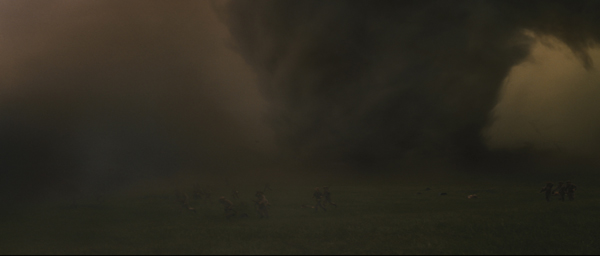 |
|
Olivier managed this sequence as if the storm were another, separate project, dedicating a team of artists that had no other responsibility. Their approach was to do a lot of the work in the composite after rendering many different layers that could be stacked to effectively fill the huge space of the storm. They could layer in debris in the foreground, with other events happening in the mid-ground and finally, the background. “At first sight, we see the shape of a cloud, clearly defined. Then you see softer layers. We used a volumetric smoke simulation for the cloud, but also relied on the way the layers were combined to create the realism. For that reason we wanted to allow a lot of time in compositing. “The lighting of the tornados and clouds was a specific pass, allowing us to choose when lightning is striking and illuminating the storm. We added CG people sucked into the tornados and, because the plates were actually captured on a calm day, animated trees and broken branches to move with the storm. The monuments and fence had to be built digitally as well, in order to destroy them. “As much as anything, the three tornados, arriving one after the other, were meant to evoke a feeling of relentless strength and violence, and not necessarily be appreciated as discrete events.” www.methodstudios.com Words: Adriene Hurst |


















